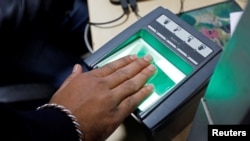India’s Supreme Court has ruled that the government’s biometric identity, or ID system for citizens is legal.
Four out of the five judges who heard the case voted Wednesday to keep the ID system in place. But the Supreme Court also ruled to limit parts of the program to protect individual privacy.
The biometric identification project is called Aadhaar. Under it, the government aims to release an individual 12-digit number to each of the nation’s citizens. This number is linked to the individual’s fingerprints and a scan of their eye, to be used as an electronic form of ID.
Critics of the system say it threatens privacy rights and warn that the information collected could be misused. Opponents also argue that companies – such as banks or telephone providers - could use the biometric ID as a requirement for service.
The government has said the system is meant to make sure its food, fuel and other assistance reaches citizens who need it. It aims to block theft and other problems in India’s $23.6-billion-a-year food public aid program.
The Supreme Court in its decision said the Aadhaar system provides more good than risk. The judge who announced the ruling said the court believed the best solution was to fix the current public assistance system rather than end it.
The judges ruled that anyone seeking any government services will be required by law to have a biometric ID number.
But the court said companies could not require Indians to provide their ID to register for telephones and other services. The judges also ruled that children would not need Aadhaar to begin school because education is a fundamental right of all citizens.
The court also said the law must include a government process to help people who have information misused or their identities stolen as a result of the system.
The biometric ID system was first proposed by the Congress Party government in 2010. But it expanded under Prime Minister Narendra Modi, whose BJP party came to power in 2014.
In a related case last year, the government went to the Supreme Court to argue that Indians did not have a fundamental right to privacy. The government lost, with the court ruling that privacy was the right of every citizen guaranteed by the constitution.
I’m Bryan Lynn.
Bryan Lynn wrote this story for VOA Learning English, based on reports from Reuters, Agence France-Presse and VOA News. was the editor.
We want to hear from you. Write to us in the Comments section, and visit our Facebook page.
_____________________________________________________________
Words in This Story
biometric – n. involving the application of statistical analysis to biological data
scan – n. looking at the inside of something by using a special machine
fundamental – adj. relating to the most important or main part of something










